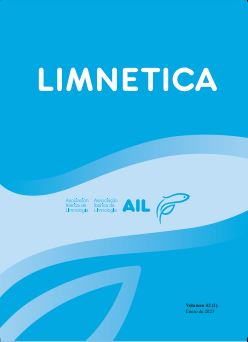Periphyton responses to enrichment and nutrient dilution in two mesocosm experiments in a shallow hypereutrophic reservoir
Resumen
Periphyton can contribute to maintaining oligotrophic conditions in restored shallow lakes and reservoirs. In two mesocosm experiments, we evaluated the periphyton responses to enrichment and nutrient dilution in a hypereutrophic reservoir. Effects of the isolated and combined N and P enrichment and dilution levels on periphyton biomass and structure on artificial substrate were investigated. For colonization of periphyton, glass slides were exposed for 14 days (enrichment experiment) and 21 days (dilution experiment) at 20 cm deep. We monitored the effects of N and P enrichment and dilution on the algal biomass, density, and species composition in the periphyton. P was a primary limiting factor for periphyton development. Periphyton algal density and biomass increased in response to combined and isolated P enrichment. Only the 75 % dilution had a positive and significant effect on biomass and algal density in the periphyton. In both mesocosm experiments, the periphyton structure changed, with Nitzschia palea (Kutz.) Smith responding positively to P enrichment and negatively to dilution. Achnanthidium minutissimum Complex becoming dominant following 50 % and 75 % eutrophic water dilution. Our results suggest that major environmental changes are necessary for a heterogeneous algal community structure in the periphyton in hypereutrophic conditions. We conclude that, after a restoration process that reduces P-competition with phytoplankton and shading, periphyton can become an important primary producer in a hypereutrophic reservoir.
Descargas
Publicado
Número
Sección
Licencia
Los autores que publican en esta revista están de acuerdo con los siguientes términos:
- Limnetica está bajo una licencia de Creative Commons Atribución-NoComercial 4.0 Internacional.
b. Los autores pueden establecer por separado acuerdos adicionales para la distribución no exclusiva de la versión de la obra publicada en la revista (por ejemplo, situarlo en un repositorio institucional o publicarlo en un libro), con un reconocimiento de su publicación inicial en esta revista.
c. Se permite y se anima a los autores a difundir sus trabajos electrónicamente (por ejemplo, en repositorios institucionales o en su propio sitio web) antes y durante el proceso de envío, ya que puede dar lugar a intercambios productivos, así como a una citación más temprana y mayor de los trabajos publicados (Véase The Effect of Open Access) (en inglés).


